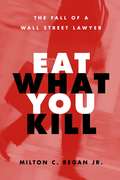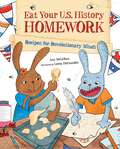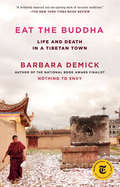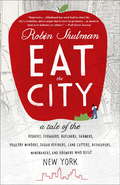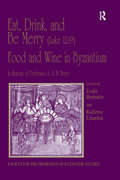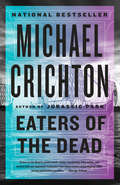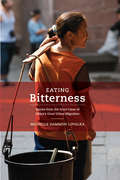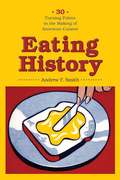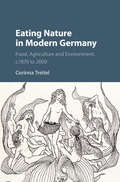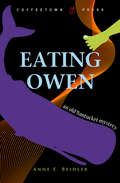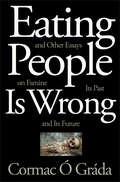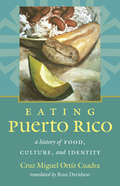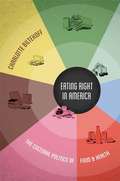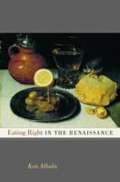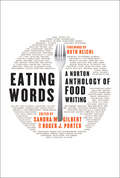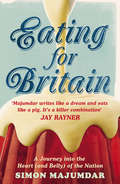- Table View
- List View
Eat What You Kill: The Fall of a Wall Street Lawyer
by Milton C. Regan Jr.He had it all, and then he lost it. But why did he do it, risking everything-wealth, success, livelihood, freedom, and the security of family? Eat What You Kill is the story of John Gellene, a rising star and bankruptcy partner at one of Wall Street's most venerable law firms. But when Gellene became entangled in a web of conflicting corporate and legal interests involving one of his clients, he was eventually charged with making false statements, indicted, found guilty of a federal crime, and sentenced to prison. Milton C. Regan Jr. uses Gellene's case to prove that such conflicting interests are now disturbingly commonplace in the world of American corporate finance. Combining a journalist's eye with sharp psychological insight, Regan spins Gellene's story into a gripping drama of fundamental tensions in modern-day corporate practice and describes in perfect miniature the inexorable confluence of the interests of American corporations and their legal counselors. This confluence may seem natural enough, but because these law firms serve many masters-corporations, venture capitalists, shareholder groups-it has paradoxically led to deep, pervasive conflicts of interest. Eat What You Kill gives us the story of a man trapped in this labyrinth, and reveals the individual and systemic factors that contributed to Gellene's demise.
Eat Your U.S. History Homework: Recipes for Revolutionary Minds (Eat Your Homework #3)
by Ann McCallumExamine the birth of America through a delicious lens: FOOD! This history-themed recipe book is third in a scrumptious series and proves that cooking never gets old. This collection of unique recipes will fill you up with lip-smacking history facts that reveal what cuisine was like for people between the 1600s to the 1800s, during the birth of America. Budding chefs will devour time-period inspired recipes for healthy entrees and snacks, as well as desserts, including Thanksgiving Succotash, Revolutionary Honey-Jumble Cookies, Colonial Cherry-Berry Grunts, and more. History buffs will appreciate the diverse experiences represented, from the Native Americans and the pilgrims, to slaves and plantation owners."...some tasty ways for kids to connect with the history curriculum."-Booklist
Eat the Buddha: Life and Death in a Tibetan Town
by Barbara DemickA gripping portrait of modern Tibet told through the lives of its people, from the bestselling author of Nothing to Envy. &“You simply cannot understand China without reading Barbara Demick on Tibet.&”—Evan Osnos, author of Age of Ambition Just as she did with North Korea, award-winning journalist Barbara Demick explores one of the most hidden corners of the world. She tells the story of a Tibetan town perched eleven thousand feet above sea level that is one of the most difficult places in all of China for foreigners to visit. Ngaba was one of the first places where the Tibetans and the Chinese Communists encountered one another. In the 1930s, Mao Zedong&’s Red Army fled into the Tibetan plateau to escape their adversaries in the Chinese Civil War. By the time the soldiers reached Ngaba, they were so hungry that they looted monasteries and ate religious statues made of flour and butter—to Tibetans, it was as if they were eating the Buddha. Their experiences would make Ngaba one of the engines of Tibetan resistance for decades to come, culminating in shocking acts of self-immolation. Eat the Buddha spans decades of modern Tibetan and Chinese history, as told through the private lives of Demick&’s subjects, among them a princess whose family is wiped out during the Cultural Revolution, a young Tibetan nomad who becomes radicalized in the storied monastery of Kirti, an upwardly mobile entrepreneur who falls in love with a Chinese woman, a poet and intellectual who risks everything to voice his resistance, and a Tibetan schoolgirl forced to choose at an early age between her family and the elusive lure of Chinese money. All of them face the same dilemma: Do they resist the Chinese, or do they join them? Do they adhere to Buddhist teachings of compassion and nonviolence, or do they fight? Illuminating a culture that has long been romanticized by Westerners as deeply spiritual and peaceful, Demick reveals what it is really like to be a Tibetan in the twenty-first century, trying to preserve one&’s culture, faith, and language against the depredations of a seemingly unstoppable, technologically all-seeing superpower. Her depiction is nuanced, unvarnished, and at times shocking.
Eat the City: A Tale of the Fishers, Foragers, Butchers, Farmers, Poultry Minders, Sugar Refiners, Cane Cutters, Beekeepers, Winemakers, and Brewers Who Built New York
by Robin ShulmanNew York is not a city for growing and manufacturing food. It's a money and real estate city, with less naked earth and industry than high-rise glass and concrete. Yet in this intimate, visceral, and beautifully written book, Robin Shulman introduces the people of New York City - both past and present - who do grow vegetables, butcher meat, fish local waters, cut and refine sugar, keep bees for honey, brew beer, and make wine. In the most heavily built urban environment in the country, she shows an organic city full of intrepid and eccentric people who want to make things grow. What's more, Shulman artfully places today's urban food production in the context of hundreds of years of history, and traces how we got to where we are. In these pages meet Willie Morgan, a Harlem man who first grew his own vegetables in a vacant lot as a front for his gambling racket. And David Selig, a beekeeper in the Red Hook section of Brooklyn who found his bees making a mysteriously red honey. Get to know Yolene Joseph, who fishes crabs out of the waters off Coney Island to make curried stews for her family. Meet the creators of the sickly sweet Manischewitz wine, whose brand grew out of Prohibition; and Jacob Ruppert, who owned a beer empire on the Upper East Side, as well as the New York Yankees. Eat the City is about how the ability of cities to feed people has changed over time. Yet it is also, in a sense, the story of the things we long for in cities today: closer human connections, a tangible link to more basic processes, a way to shape more rounded lives, a sense of something pure. Of course, hundreds of years ago, most food and drink consumed by New Yorkers was grown and produced within what are now the five boroughs. Yet people rarely realize that long after New York became a dense urban agglomeration, innovators, traditionalists, migrants and immigrants continued to insist on producing their own food. This book shows the perils and benefits--and the ironies and humor--when city people involve themselves in making what they eat. Food, of course, is about hunger. We eat what we miss and what we want to become, the foods of our childhoods and the symbols of the lives we hope to lead. With wit and insight, Eat the City shows how in places like New York, people have always found ways to use their collective hunger to build their own kind of city. ROBIN SHULMAN is a writer and reporter whose work has appeared in the New York Times, the Washington Post, the Los Angeles Times, Slate, the Guardian, and many other publications. She lives in New York City.
Eat, Drink, and Be Merry: Papers of the 37th Annual Spring Symposium of Byzantine Studies, In Honour of Professor A.A.M. Bryer (Publications of the Society for the Promotion of Byzantine Studies #13)
by Leslie Brubaker Kallirroe LinardouThis volume brings together a group of scholars to consider the rituals of eating together in the Byzantine world, the material culture of Byzantine food and wine consumption, and the transport and exchange of agricultural products. The contributors present food in nearly every conceivable guise, ranging from its rhetorical uses - food as a metaphor for redemption; food as politics; eating as a vice, abstinence as a virtue - to more practical applications such as the preparation of food, processing it, preserving it, and selling it abroad. We learn how the Byzantines viewed their diet, and how others - including, surprisingly, the Chinese - viewed it. Some consider the protocols of eating in a monastery, of dining in the palace, or of roughing it on a picnic or military campaign; others examine what serving dishes and utensils were in use in the dining room and how this changed over time. Throughout, the terminology of eating - and especially some of the more problematic terms - is explored. The chapters expand on papers presented at the 37th Annual Spring Symposium of Byzantine Studies, held at the University of Birmingham under the auspices of the Society for the Promotion of Byzantine Studies, in honour of Professor A.A.M. Bryer, a fitting tribute for the man who first told the world about Byzantine agricultural implements.
Eater of Souls (The Lord Meren Mysteries #4)
by Lynda S. RobinsonA spate of murders is either divine justice or earthly evil in this historical mystery that &“brings ancient Egypt alive&” (Publishers Weekly, starred review). In the city of Memphis in ancient Egypt, multiple victims have been found with their hearts torn from their chests, and white feathers left in their place. The latest corpse belongs to a Hittite prince who insulted King Tut—in whose service Lord Meren works. Now Meren must put aside his quiet inquiries into the death of Queen Nefertiti to investigate this new string of killings. The circumstances suggest the likely culprit is the god Ammut. But if the murderer is in fact mortal, it&’ll be up to Meren and his adopted son to end the carnage . . . &“Lord Meren&’s fourth case taxes all his skills as investigator, statesman, warrior, householder, and father, while displaying his author&’s powers of invention and intrigue at their peak.&” —Kirkus Reviews &“Ms. Robinson brings warm life and much wit to the machinations at court.&” —The New York Times Book Review
Eaters of the Dead
by Michael CrichtonFrom the bestselling author of Jurassic Park, Timeline, and Sphere comes an epic tale of unspeakable horror. It is 922 A.D. The refined Arab courtier Ibn Fadlan is accompanying a party of Viking warriors back to their home. He is appalled by their customs--the gratuitous sexuality of their women, their disregard for cleanliness, and their cold-blooded sacrifices. As they enter the frozen, forbidden landscape of the North--where the day's length does not equal the night's, where after sunset the sky burns in streaks of color--Fadlan soon discovers that he has been unwillingly enlisted to combat the terrors in the night that come to slaughter the Vikings, the monsters of the mist that devour human flesh. But just how he will do it, Fadlan has no idea.
Eating Anxiety: The Perils of Food Politics
by Chad LavinDebates about obesity are really about the meaning of responsibility. The trend toward local foods reflects the changing nature of space due to new communication technologies. Vegetarian theory capitalizes on biotechnology&’s challenge to the meaning of species. And food politics, as this book makes powerfully clear, is actually about the political anxieties surrounding globalization. In Eating Anxiety, Chad Lavin argues that our culture&’s obsession with diet, obesity, meat, and local foods enacts ideological and biopolitical responses to perceived threats to both individual and national sovereignty. Using the occasion of eating to examine assumptions about identity, objectivity, and sovereignty that underwrite so much political order, Lavin explains how food functions to help structure popular and philosophical understandings of the world and the place of humans within it. He introduces the concept of digestive subjectivity and shows how this offers valuable resources for rethinking cherished political ideals surrounding knowledge, democracy, and power. Exploring discourses of food politics, Eating Anxiety links the concerns of food—especially issues of sustainability, public health, and inequality—to the evolution of the world order and the possibilities for democratic rule. It forces us to question the significance of consumerist politics and—simultaneously—the relationship between politics and ethics, public and private.
Eating Beauty: The Eucharist and the Spiritual Arts of the Middle Ages
by Ann W. Astell"The enigmatic link between the natural and artistic beauty that is to be contemplated but not eaten, on the one hand, and the eucharistic beauty that is both seen (with the eyes of faith) and eaten, on the other, intrigues me and inspires this book. One cannot ask theo-aesthetic questions about the Eucharist without engaging fundamental questions about the relationship between beauty, art (broadly defined), and eating."—from Eating BeautyIn a remarkable book that is at once learned, startlingly original, and highly personal, Ann W. Astell explores the ambiguity of the phrase "eating beauty." The phrase evokes the destruction of beauty, the devouring mouth of the grave, the mouth of hell. To eat beauty is to destroy it. Yet in the case of the Eucharist the person of faith who eats the Host is transformed into beauty itself, literally incorporated into Christ. In this sense, Astell explains, the Eucharist was "productive of an entire 'way' of life, a virtuous life-form, an artwork, with Christ himself as the principal artist." The Eucharist established for the people of the Middle Ages distinctive schools of sanctity—Cistercian, Franciscan, Dominican, and Ignatian—whose members were united by the eucharistic sacrament that they received.Reading the lives of the saints not primarily as historical documents but as iconic expressions of original artworks fashioned by the eucharistic Christ, Astell puts the "faceless" Host in a dynamic relationship with these icons. With the advent of each new spirituality, the Christian idea of beauty expanded to include, first, the marred beauty of the saint and, finally, that of the church torn by division—an anti-aesthetic beauty embracing process, suffering, deformity, and disappearance, as well as the radiant lightness of the resurrected body. This astonishing work of intellectual and religious history is illustrated with telling artistic examples ranging from medieval manuscript illuminations to sculptures by Michelangelo and paintings by Salvador Dalí. Astell puts the lives of medieval saints in conversation with modern philosophers as disparate as Simone Weil and G. W. F. Hegel.
Eating Bitterness
by Michelle LoyalkaEvery year over 200 million peasants flock to China's urban centers, providing a profusion of cheap labor that helps fuel the country's staggering economic growth. Award-winning journalist Michelle Dammon Loyalka follows the trials and triumphs of eight such migrants--including a vegetable vendor, an itinerant knife sharpener, a free-spirited recycler, and a cash-strapped mother--offering an inside look at the pain, self-sacrifice, and uncertainty underlying China's dramatic national transformation. At the heart of the book lies each person's ability to "eat bitterness"--a term that roughly means to endure hardships, overcome difficulties, and forge ahead. These stories illustrate why China continues to advance, even as the rest of the world remains embroiled in financial turmoil. At the same time, Eating Bitterness demonstrates how dealing with the issues facing this class of people constitutes China's most pressing domestic challenge.
Eating Her Curries and Kway: A Cultural History of Food in Singapore
by Nicole TaruleviczWhile eating is a universal experience, for Singaporeans it carries strong national connotations. The popular Singaporean-English phrase "Die die must try" is not so much hyperbole as it is a reflection of the lengths that Singaporeans will go to find great dishes. <P><P> In Eating Her Curries and Kway: A Cultural History of Food in Singapore, Nicole Tarulevicz argues that in a society that has undergone substantial change in a relatively short amount of time, food serves Singaporeans as a poignant connection to the past. Covering the period from British settlement in 1819 to the present and focusing on the post-1965 postcolonial era, Tarulevicz tells the story of Singapore through the production and consumption of food. <P><P> Analyzing a variety of sources that range from cookbooks to architectural and city plans, Tarulevicz offers a thematic history of this unusual country, which was colonized by the British and operated as a port within Malaya, but which is without a substantial pre-colonial history. <P><P>Connecting food culture to the larger history of Singapore, she discusses various topics including domesticity and home economics, housing and architecture, advertising, and the regulation of food-related manners and public behavior such as hawking, littering, and chewing gum. <P><P>Moving away from the predominantly political and economic focus of other histories of Singapore, Tarulevicz provides an important alternative reading of Singaporean society.
Eating History: Thirty Turning Points in the Making of American Cuisine
by Andrew F. SmithFood expert and celebrated food historian Andrew F. Smith recounts-in delicious detail-the creation of contemporary American cuisine. The diet of the modern American wasn't always as corporate, conglomerated, and corn-rich as it is today, and the style of American cooking, along with the ingredients that compose it, has never been fixed. With a cast of characters including bold inventors, savvy restaurateurs, ruthless advertisers, mad scientists, adventurous entrepreneurs, celebrity chefs, and relentless health nuts, Smith pins down the truly crackerjack history behind the way America eats. Smith's story opens with early America, an agriculturally independent nation where most citizens grew and consumed their own food. Over the next two hundred years, however, Americans would cultivate an entirely different approach to crops and consumption. Advances in food processing, transportation, regulation, nutrition, and science introduced highly complex and mechanized methods of production. The proliferation of cookbooks, cooking shows, and professionally designed kitchens made meals more commercially, politically, and culturally potent. To better understand these trends, Smith delves deeply and humorously into their creation. Ultimately he shows how, by revisiting this history, we can reclaim the independent, locally sustainable roots of American food.
Eating History: Thirty Turning Points in the Making of American Cuisine (Arts and Traditions of the Table: Perspectives on Culinary History)
by Andrew SmithFood expert and celebrated food historian Andrew F. Smith recounts-in delicious detail-the creation of contemporary American cuisine. The diet of the modern American wasn't always as corporate, conglomerated, and corn-rich as it is today, and the style of American cooking, along with the ingredients that compose it, has never been fixed. With a cast of characters including bold inventors, savvy restaurateurs, ruthless advertisers, mad scientists, adventurous entrepreneurs, celebrity chefs, and relentless health nuts, Smith pins down the truly crackerjack history behind the way America eats.Smith's story opens with early America, an agriculturally independent nation where most citizens grew and consumed their own food. Over the next two hundred years, however, Americans would cultivate an entirely different approach to crops and consumption. Advances in food processing, transportation, regulation, nutrition, and science introduced highly complex and mechanized methods of production. The proliferation of cookbooks, cooking shows, and professionally designed kitchens made meals more commercially, politically, and culturally potent. To better understand these trends, Smith delves deeply and humorously into their creation. Ultimately he shows how, by revisiting this history, we can reclaim the independent, locally sustainable roots of American food.
Eating Nature in Modern Germany: Food, Agriculture and Environment, c.1870 to 2000
by Corinna TreitelAdolf Hitler was a vegetarian and the Dachau concentration camp had an organic herb garden. Vegetarianism, organic farming, and other such practices have enticed a wide variety of Germans, from socialists, liberals, and radical anti-Semites in the nineteenth century to fascists, communists, and Greens in the twentieth century. Corinna Treitel offers a fascinating new account of how Germans became world leaders in developing more 'natural' ways to eat and farm. Used to conserve nutritional resources with extreme efficiency at times of hunger and to optimize the nation's health at times of nutritional abundance, natural foods and farming belong to the biopolitics of German modernity. Eating Nature in Modern Germany brings together histories of science, medicine, agriculture, the environment, and popular culture to offer the most thorough and historically comprehensive treatment yet of this remarkable story.
Eating Owen: An Old Nantucket Mystery
by Anne E. BeidlerBased on the tragic true story of the sinking of the Essex, a Nantucket family torn apart by fate—and a whale that would come to be known as Moby Dick. In the early 1800s, every young man on the island of Nantucket dreamed of travelling the world aboard one of the massive whaling ships in the harbor. Owen Coffin was no different—and when he was chosen to join the crew of the Essex, he thought his future was bright on the horizon. He was tragically wrong. At sea, the Essex was attacked and sunk by a raging whale, setting the survivors adrift on a horrific, months-long journey that few would survive. Some resorted to cannibalism, including Owen. But by the time they were rescued, Owen had reportedly been fairly elected to be killed and eaten. But no one can truly say what really happened. Here is the fictionalized story of four members of the Coffin family: Abigail, Nancy, Zimri, and Owen. It is the harrowing story that would eventually be told in Herman Melville’s Moby Dick, of a family whose name would go down in history, and of a whale whose revenge could not be believed . . .
Eating People Is Wrong, and Other Essays on Famine, Its Past, and Its Future
by Cormac Ó GrádaFamines are becoming smaller and rarer, but optimism about the possibility of a famine-free future must be tempered by the threat of global warming. That is just one of the arguments that Cormac Ó Gráda, one of the world's leading authorities on the history and economics of famine, develops in this wide-ranging book, which provides crucial new perspectives on key questions raised by famines around the globe between the seventeenth and twenty-first centuries.The book begins with a taboo topic. Ó Gráda argues that cannibalism, while by no means a universal feature of famines and never responsible for more than a tiny proportion of famine deaths, has probably been more common during very severe famines than previously thought. The book goes on to offer new interpretations of two of the twentieth century's most notorious and controversial famines, the Great Bengal Famine and the Chinese Great Leap Forward Famine. Ó Gráda questions the standard view of the Bengal Famine as a perfect example of market failure, arguing instead that the primary cause was the unwillingness of colonial rulers to divert food from their war effort. The book also addresses the role played by traders and speculators during famines more generally, invoking evidence from famines in France, Ireland, Finland, Malawi, Niger, and Somalia since the 1600s, and overturning Adam Smith's claim that government attempts to solve food shortages always cause famines.Thought-provoking and important, this is essential reading for historians, economists, demographers, and anyone else who is interested in the history and possible future of famine.
Eating Puerto Rico
by Cruz Miguel Ortíz CuadraAvailable for the first time in English, Cruz Miguel Ortiz Cuadra's magisterial history of the foods and eating habits of Puerto Rico unfolds into an examination of Puerto Rican society from the Spanish conquest to the present. Each chapter is centered on an iconic Puerto Rican foodstuff, from rice and cornmeal to beans, roots, herbs, fish, and meat. Ortiz shows how their production and consumption connects with race, ethnicity, gender, social class, and cultural appropriation in Puerto Rico. Using a multidisciplinary approach and a sweeping array of sources, Ortiz asks whether Puerto Ricans really still are what they ate. Whether judging by a host of social and economic factors--or by the foods once eaten that have now disappeared--Ortiz concludes that the nature of daily life in Puerto Rico has experienced a sea change.
Eating Right in America: The Cultural Politics of Food and Health
by Charlotte BiltekoffEating Right in America is a powerful critique of dietary reform in the United States from the late nineteenth-century emergence of nutritional science through the contemporary alternative food movement and campaign against obesity. Charlotte Biltekoff analyzes the discourses of dietary reform, including the writings of reformers, as well as the materials they created to bring their messages to the public. She shows that while the primary aim may be to improve health, the process of teaching people to "eat right" in the U.S. inevitably involves shaping certain kinds of subjects and citizens, and shoring up the identity and social boundaries of the ever-threatened American middle class. Without discounting the pleasures of food or the value of wellness, Biltekoff advocates a critical reappraisal of our obsession with diet as a proxy for health. Based on her understanding of the history of dietary reform, she argues that talk about "eating right" in America too often obscures structural and environmental stresses and constraints, while naturalizing the dubious redefinition of health as an individual responsibility and imperative.
Eating Right in the Renaissance
by Ken AlbalaEating right has been an obsession for longer than we think. Renaissance Europe had its own flourishing tradition of dietary advice. Then, as now, an industry of experts churned out diet books for an eager and concerned public.
Eating Smoke: Fire in Urban America, 1800–1950
by Mark TebeauDuring the period of America's swiftest industrialization and urban growth, fire struck fear in the hearts of city dwellers as did no other calamity. Before the Civil War, sweeping blazes destroyed more than $200 million in property in the nation's largest cities. Between 1871 and 1906, conflagrations left Chicago, Boston, Baltimore, and San Francisco in ruins. Into the twentieth century, this dynamic hazard intensified as cities grew taller and more populous, confounding those who battled it. Firefighters' death-defying feats captured the popular imagination but too often failed to provide more than symbolic protection. Hundreds of fire insurance companies went bankrupt because they could not adequately deal with the effects of even smaller blazes.Firefighters and fire insurers created a physical and cultural infrastructure whose legacy—in the form of heroic firefighters, insurance policies, building standards, and fire hydrants—lives on in the urban built environment. In Eating Smoke, Mark Tebeau shows how the changing practices of firefighters and fire insurers shaped the built landscape of American cities, the growth of municipal institutions, and the experience of urban life. Drawing on a wealth of fire department and insurance company archives, he contrasts the invention of a heroic culture of firefighters with the rational organizational strategies by fire underwriters. Recognizing the complexity of shifting urban environments and constantly experimenting with tools and tactics, firefighters fought fire ever more aggressively—"eating smoke" when they ventured deep into burning buildings or when they scaled ladders to perform harrowing rescues. In sharp contrast to the manly valor of firefighters, insurers argued that the risk was quantifiable, measurable, and predictable. Underwriters managed hazard with statistics, maps, and trade associations, and they eventually agitated for building codes and other reforms, which cities throughout the nation implemented in the twentieth century. Although they remained icons of heroism, firefighters' cultural and institutional authority slowly diminished. Americans had begun to imagine fire risk as an economic abstraction.By comparing the simple skills employed by firefighters—climbing ladders and manipulating hoses—with the mundane technologies—maps and accounting charts—of insurers, the author demonstrates that the daily routines of both groups were instrumental in making intense urban and industrial expansion a less precarious endeavor.
Eating Words: A Norton Anthology of Food Writing
by Ruth Reichl Sandra M. Gilbert Roger J. Porter“Food writing spans centuries and philosophies. . . . At long last there’s a Norton Anthology with all the most important works.”—Eater Edited by influential literary critic Sandra M. Gilbert and award-winning restaurant critic and professor of English Roger Porter, Eating Words gathers food writing of literary distinction and vast historical sweep into one groundbreaking volume. Beginning with the taboos of the Old Testament and the tastes of ancient Rome, and including travel essays, polemics, memoirs, and poems, the book is divided into sections such as “Food Writing Through History,” “At the Family Hearth,” “Hunger Games: The Delight and Dread of Eating,” “Kitchen Practices,” and “Food Politics.” Selections from writings by Julia Child, Anthony Bourdain, Bill Buford, Michael Pollan, Molly O’Neill, Calvin Trillin, and Adam Gopnik, along with works by authors not usually associated with gastronomy—Maxine Hong Kingston, Henry Louis Gates Jr., Hemingway, Chekhov, and David Foster Wallace—enliven and enrich this comprehensive anthology. “We are living in the golden age of food writing,” proclaims Ruth Reichl in her preface to this savory banquet of literature, a must-have for any food lover. Eating Words shows how right she is.
Eating and Being: A History of Ideas about Our Food and Ourselves
by Steven ShapinWhat we eat, who we are, and the relationship between the two. Eating and Being is a history of Western thinking about food, eating, knowledge, and ourselves. In modern thought, eating is about what is good for you, not about what is good. Eating is about health, not about virtue. Yet this has not always been the case. For a great span of the past—from antiquity through about the middle of the eighteenth century—one of the most pervasive branches of medicine was known as dietetics, prescribing not only what people should eat but also how they should order many aspects of their lives, including sleep, exercise, and emotional management. Dietetics did not distinguish between the medical and the moral, nor did it acknowledge the difference between what was good for you and what was good. Dietetics counseled moderation in all things, where moderation was counted as a virtue as well as the way to health. But during the nineteenth century, nutrition science began to replace the language of traditional dietetics with the vocabulary of proteins, fats, carbohydrates, and calories, and the medical and the moral went their separate ways. Steven Shapin shows how much depended upon that shift, and he also explores the extent to which the sensibilities of dietetics have been lost. Throughout this rich history, he evokes what it felt like to eat during another historical period and invites us to reflect on what it means to feel about food as we now do. Shapin shows how the change from dietetics to nutrition science fundamentally altered how we think about our food and its powers, our bodies, and our minds.
Eating and Ethics in Shakespeare's England
by David B. GoldsteinDavid B. Goldstein argues for a new understanding of Renaissance England from the perspective of communal eating. Rather than focus on traditional models of interiority, choice and consumption, Goldstein demonstrates that eating offered a central paradigm for the ethics of community formation. The book examines how sharing food helps build, demarcate and destroy relationships – between eater and eaten, between self and other, and among different groups. Tracing these eating relations from 1547 to 1680 – through Shakespeare, Milton, religious writers and recipe book authors – Goldstein shows that to think about eating was to engage in complex reflections about the body's role in society. In the process, he radically rethinks the communal importance of the Protestant Eucharist. Combining historicist literary analysis with insights from social science and philosophy, the book's arguments reverberate well beyond the Renaissance. Ultimately, Eating and Ethics in Shakespeare's England forces us to rethink our own relationship to food.
Eating for Britain
by Simon Majumdar'Who are these people? Look at what they eat.' Simon Majumdar travels the country to find out what British food -- from Arbroath Smokies to Welsh rarebit to chicken tikka masala -- reveals about British identity. Exploring the history of British food, he celebrates the wealth of fare on offer today, and meets the people all over the country -- the farmers, the fishermen, the brewers, bakers and cheese makers -- who have given the British reason to love their food again. Join Simon as he becomes a judge at the Great British Pie Competition (where, to his sorrow, he ends up judging vegetarian pies), as he learns to make Balti with a true Brummie, hunts for grouse, and sees seaside rock being made in Blackpool. EATING FOR BRITAIN is an impassioned and hilarious journey into the meaning of eating British.
Eating for Britain
by Simon Majumdar'Who are these people? Look at what they eat.' Simon Majumdar travels the country to find out what British food -- from Arbroath Smokies to Welsh rarebit to chicken tikka masala -- reveals about British identity. Exploring the history of British food, he celebrates the wealth of fare on offer today, and meets the people all over the country -- the farmers, the fishermen, the brewers, bakers and cheese makers -- who have given the British reason to love their food again. Join Simon as he becomes a judge at the Great British Pie Competition (where, to his sorrow, he ends up judging vegetarian pies), as he learns to make Balti with a true Brummie, hunts for grouse, and sees seaside rock being made in Blackpool. EATING FOR BRITAIN is an impassioned and hilarious journey into the meaning of eating British.
